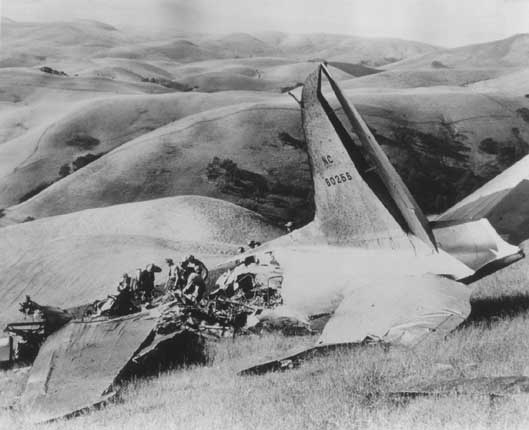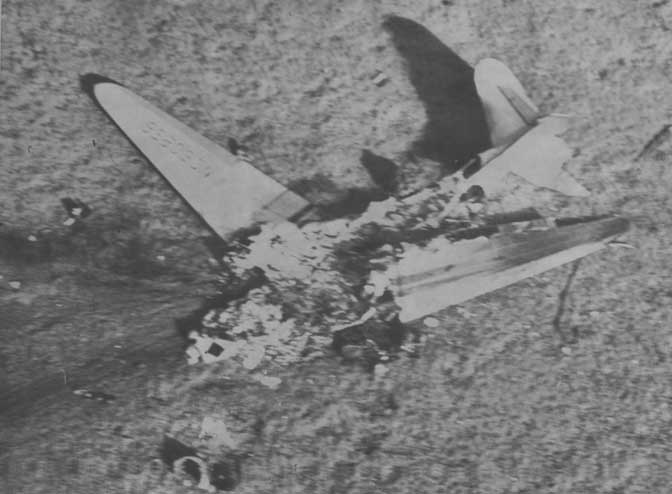Have Plane, Will Travel…George E. Batchelor, originally from Oklahoma, loved all things aviation. His first job as a mechanic was at North American Aviation (NAA), making 30 cents an hour. While with NAA, he assisted in the design for the P-51. At the age of 16, he learned to fly, and flew DC-4s in Europe with the U.S. Army Air Corps in World War II, rising to the rank of Major. After the war was over, Batchelor brought a surplus airplane, a DC-3, from the U.S. government. However, the plane was located in Hawaii, he was in California, and a stock DC-3 did not have the range to make the long flight across the Pacific. Batchelor flew to Hawaii, and modified the plane’s fuel system such to make the eighteen-hour flight a reality. Once the plane arrived in Santa Monica, he sold the plane for $25,000. And with that, ‘Arrow Air’ was born. Operated out of an office constructed from an engine crate at the Lomita Airstrip (today known as the Torrance Municipal Airport), Batchelor grew the budding airline with several non-scheduled air carriers, willing to fly whatever-whenever-wherever. One of these ‘non-sked’ carriers was California Arrow Airways. Established on August 12, 1949, as an intrastate air carrier, it began providing scheduled service flying a triangle between Burbank, Oakland, and Sacramento. Although the airline held no certificate or license for this type of operation from the Civil Aeronautics Administration, the airline functioned unhindered. “Trust Your Instruments...”One of the earliest tenets taught to most aviators. A relatively sound principle to safe flight, with only one exception: When your instruments are wrong. On the afternoon of Wednesday, December 7, 1949, DC-3 #N60256 flew from the Burbank Airport, where California Arrow Airline’s home office was, north to Oakland Airport. The flight crew that day consisted of pilot James Stanley Garnett, 33, of Redondo Beach; co-pilot Joseph Meade Dillon, 38, of Los Angeles; and stewardess Thelma Susan Devore, 24, of Los Angeles. Leaving at 2:20 in the afternoon, the flight arrived in Oakland without incident, ten passengers disembarked, and preparations were made for its next leg of the flight, northeast to Sacramento. However, prior to their departure from Oakland, the crew was advised that poor weather had set in, precluding a normal flight, and that a flight under “instrument flight rules” (IFR) would be required. Six passengers were now aboard the plane, bound for Sacramento and Burbank. Mrs. Frances Marian Kimball. 23, of Pasadena, and her two children, Leland Cummings Kimball III, aged 18 months, & John Wesley Kimball, aged 8 months. Mrs. Kimball was going to visit relatives in Sacramento, and had expected her husband, Lt. Leland C. Kimball Jr, home from Europe, where he served in the Air Force, the day before Christmas. Homeward Bound...Also bound for Sacramento was Vincent N. Figley, 37, of Laguna Beach, a waiter at the Victor Hugo Inn. He was headed to Sacramento to visit his parents whom lived in Sacramento. Lastly, Lorraine B. Batchelor, 26, and her 2-year-old son, George “Patrick” Batchelor, 2, were also aboard, bound for their home in Burbank. Mrs. Batchelor was the wife of George Batchelor, the airline’s president and founder. The flight crew filed for an IFR flight plan, and took off at 4:46 PM. Seven minutes into the flight, they received their flight clearance to Sacramento under IFR, at a flight altitude of 4,000 feet, well clear of any terrain or obstacles that would impede a safe flight. Continuing along its route, the DC-3 reported its location at the Richmond radio intersection at 5:08. The crew predicted that they would arrive at their next checkpoint, the Fairfield radio navigation station, in 15 minutes. The air traffic controllers queried the DC-3 as to its altitude. When the reply of “4,000 feet” was received, the controllers then awaited their next call over Fairfield. The call never came. It was due in Sacramento at 5:33 PM and would have been out of gas at 7:33. The Search is On… The flight was reported overdue in Sacramento an hour later, and immediately an air & ground search began for the missing airliner. Focused in the area between Sacramento and Richmond, the search was hampered that night by rain and clouds, the very bad weather that forced the DC-3’s crew to file an IFR flight plan. Searchers from Hamilton Field, as well as Coast Guard seaplanes and helicopters, investigated several reports of the downed plane in Franklin Canyon, near Martinez, as well as reports around Napa and Fairfield. However, the next morning, Lt. Jerry Rea, flying a Coast Guard search plane, spotted the burning wreckage of the DC-3 in the hills north of Benicia. At nearly the same moment, Clifford H DeCius, an Army guard stationed at the Benicia Arsenal, spotted smoke from the wreck. A search helicopter from Hamilton Field was dispatched, and landed near the crash site. A grim task fell before the helicopter’s crew, making the report of no survivors being found alive. George Batchelor arrived at the crash site to see the remains of his wife and child removed from the still-smoldering wreckage. According to witness reports of the time, only the tail and right wing were recognizable in the wreckage of the plane. Enter the Feds... Investigators from the Civil Aeronautics Board (CAB), the predecessor of today’s National Transportation Safety Board, arrived from Los Angeles to search for clues into why 9 people had died in the Benicia hills. Focusing on the weather as a key factor in the accident, the investigators noted that the aircraft’s engines were operating at maximum power, and not at the cruise settings that would be expected. According to investigators, the aircraft was in a steep climb, as if to avoid the terrain, when the crash occurred. So powerful and unexpected was the crash, that upon impact, both engines were ripped from their mountings, as the aircraft continued to skid 150 feet up the slope of the hills, where it burst into flames. The CAB also noted that the impact occurred nearly 3,200 feet below the aircraft’s reported altitude from only minutes before the crash. In the time before radar tracking, black boxes, and altitude-encoding transponders, the only way to tell what altitude the aircraft had been flying at was with its altimeter. Unfortunately, the altimeter of the DC-3 was destroyed in the crash, so the answer as to what the pilot thought his altitude was could not be determined. Laying Blame…The CAB investigation also discovered that both Garnett and Dillon had both exceeded rules limiting the number of flight hours they worked. The regulations allowed for only 8 hours of flight within a 24-hour period, and 100 hours within a 30-day period. Garnett had flown nearly 110 hours in the month of October, despite the airlines’ records showing having worked only 97.5 hours (The pilot's personal records for November were destroyed in the crash). Similar errors in record keeping were found for Dillon as well. However, since there was no indication that the plane’s altimeter was malfunctioning, the CAB investigation concluded that the only reasonable explanation for the accident was that the pilot either did not attain the prescribed altitude of 4,000 feet for his flight, or failed to maintain it during the flight, and was attempting to fly by visual reference to the ground at a much lower altitude than the one specified in his flight clearance, in a practice known among pilots as “scud-running”. Down, But Not Out… George Batchelor, despite the loss of his family, pressed on in the world of commercial aviation, and although his airlines stopped scheduled operations in 1953 due to what Batchelor saw as an anti-competitive regulatory environment, Batchelor continued leasing aircraft, often with crews, to other small airlines. In 1964, he formed International Air Leases (IAL), which became one of the most famous aircraft trading names in the aviation industry. Batchelor would amass a considerable fortune and donate much of it to homeless and children's causes before dying in July 2002, as one of the greatest aircraft-trading entrepreneurs. One of the obtuse legacies of the accident is in legal circles. After the accident, the widow and mother of Vincent Figley sued California Arrow for damages for his death that they alleged had been negligently caused by the airline. As the crash occurred in Solano County, that was where the Figleys, living in Sacramento, filed their lawsuit. However, after answering the tort, the lawyers for California Arrow asked that the trial be moved from Solano County to Los Angeles County on the grounds of convenience of 8 of their material witnesses. As the bulk of 8 witnesses from Los Angeles’ testimony were deemed as relatively immaterial to the case of California Arrow, versus the testimony of Figley’s mother, an elderly mother who counted on support from her now-deceased son, the motion for change of venue was denied. The decision was appealed at the state appellate level, where Presiding Justice Annette Abbott Adams, and the Third Appellate District of the California Court of Appeals upheld the lower court’s decision. The decision is referred frequently among those in California legal circles. Click Here to View the Text of Figley vs. California Arrow Airlines. |
